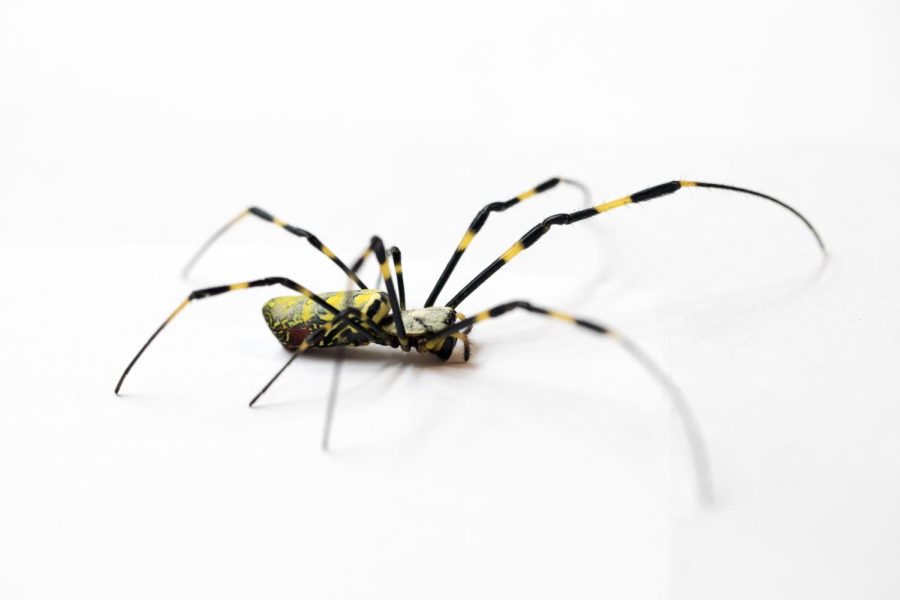Meet Jorō: America’s New Eight-Legged “Friend”
April 12, 2022
America has a new eight-legged “friend.”
Spindly, eight-legged, quiet, eight-eyed, the size of a thumb-tack to a human palm: It’s safe to say that a large majority of people are not the biggest fans of spiders, even when knowing how helpful these funky little arachnids are in maintaining a balanced ecosystem. As Samantha Salazar, an Elkhart High School senior, says: “I find spiders scary in general, but that doesn’t take away from the fact that they’re often interesting as a set of species.” It’s also safe to say that, the larger they get, the more terrifying they can be to arachnophobes and those who already aren’t all that friendly to the world’s creepy-crawlies. So what do they do when some of these spiders from Japan, who span about the size of a human palm, have started to cover over 40,000 square kilometers—or roughly around and a tad bit smaller than about 15,500 square miles—of Georgia, with webs that can reach sizes of 3 to 4 feet in diameter, and have a high potential to spread from the Southeastern states they currently reside in and travel up the East Coast of the States?
Meet the Jorō spider, believed to have arrived in the USA from Japan in 2013, with scientists not knowing how exactly they got to the states, but believing that they most likely arrived via hitching rides on shipping containers. “This Asian species of spider is very deceiving,” says Salazar, as she looks into more information about these wall crawlers. “Their size can be very intimidating at first glance, but as I read more about them, I’ve learned that they’re actually quite harmless. They pose no threat to humans or the environment or ecosystems, and they seem almost more like friendly, gentle giants. In fact, I think that they shouldn’t be branded as an invasive species, since they really aren’t causing any harm; on the contrary, they might want to avoid humans just as much as humans want to avoid them.” The average Jorō female can reach about 3 inches in length, while males tend to waver around the 8 millimeters mark, barely reaching even half the length of small females. “I find it surprising that the size of the female Jorō spider is much bigger than the size of the male,” Salazar comments upon learning about the differences in size between the two sexes. “Usually, in the animal kingdom—for most animals, at least,—the male is often times bigger and stronger than the females. In this case, with the Jorō spiders, the female is much bigger and stronger.” Salazar further continues on by expressing concerns on the likelihood of females being much more aggressive while mating with males, and resorting to cannibalism to get their food via an unfortunate male; such events can be rather common in the more carnivorous species of insects, as well. However, these fears are unfounded, as stated on Science News, “As far as Kuntner knows…Jorō spiders don’t engage in these ‘sexually conflicted’ extremes. Males being merely half size or thereabouts might explain the relatively peaceful encounters.”
Aside from peaceful reproduction being taken into account for their rapidly increasing numbers, these spiders are also incredibly hardy and may be able to weather some of the colder states and their colder weather. A previous invader and more tropical relative of the Jorō spiders, the golden orb-weaver, still have yet to really venture out of the Southeast since they invaded around 160 years ago. However, the Jorō spiders have proven to show potentially positive results in relation to dealing with the cold—while the tests were done primarily on the conveniently-large female spiders, knowing how well males survive the cold will also be important; so far, they appear to have high chances with surviving colder weather. Even if they would be unable to survive the more severe colder temperatures, they still can carry on the next generation without major fear, as covered by Science News: “Jorō sightings in the Southeast so far suggest the newer arrival needs less time than its relative to make the next generation, an advantage for farther to the north. The adults don’t need to survive deep winter in any case. Mom and dad die off, in November in Georgia, and leave their hundreds of eggs packed in silk to weather the cold and storms.” Salazar adds her thoughts on to this fact, as well, saying, “The Jorō spiders adapt very well, and I think they may get up to the East Coast in a matter of years.”
So, the females of this species of spider can be rather huge, at least in comparison to other, more common spiders, and they appear to have some ability to survive in colder weather; but, are they actually likely to spread up the East Coast and possibly into the rest of the USA? Salazar states her opinion on this question: “Honestly, I think that the Asian spider won’t be able to get up the East Coast, as they are very weak despite their size. These spiders are susceptible to changes in the climate, and therefore, I believe it is very unlikely that they will get to the East Coast. Even if they do, they certainly will not be a danger to those areas, nor cause any damage.” While the tests on the Jorō spiders’ ability to handle the cold is not very indicative of how they would actually survive in the colder climates and only showed results for the females’ relative survival, it stills gives some much rather-needed insight into their capability to survive and foresight into the potential spreading of the species even more. As well, while the largest majority of Jorō spider sightings have been reported as being in Georgia, sightings have also occurred and been reported in Tennessee and the Carolinas. The likelihood of these spiders spreading further up North from Georgia is not a sure or known thing, but as time goes on, it seems potentially more and more likely that the Jorō spider may wind up calling the Northern states home.
Salazar’s final thoughts on the Jorō’s spiders is this: “Honestly, I kind of would want to see one of these spiders myself, since they are harmless and seem rather interesting, and I might even be comfortable holding one because of that. Since their bite is apparently ‘like a pinch,’ I actually would be more afraid of a wasp than these spiders.” There is a high likelihood that several others in the states, including other fellow arachnophobes, may actually share these thoughts, opinions, and intrigue with Salazar. And, while there is no telling whether or not these arachnids masquerading as peacocks may actually wind up visiting Indiana, it certainly wouldn’t hurt to keep an eye out for these interesting little dudes.








